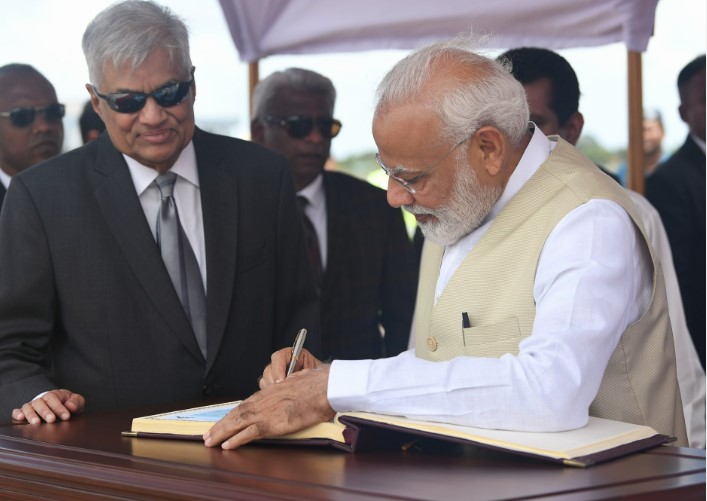Virendra Pandit
New Delhi: A week after Sri Lankan President Ranil Wickremesinghe hinted at it, his Finance Minister Ali Sabry reiterated on Saturday that the island nation is considering the possibility of allowing the usage of the Indian currency for local transactions, just like the dollar, euro, and yen to facilitate Indian tourists and businessmen.
Briefing the media in Colombo on President Wickremesinghe’s just-concluded two-day State Visit to New Delhi (July 20-21), Sabri said: “We have considered the possibility of using the Indian rupees like we accept the dollar, euro, and yen.”
President Wickremesinghe held wide-ranging bilateral discussions on a variety of issues with his host, Prime Minister Narendra Modi, on Friday.
Allowing the INR’s direct use would prevent the need for multiple currency conversions for Indian tourists and businessmen.
On Friday, the two countries noted that the decision to designate INR as currency for trade settlements between the two countries has forged stronger and mutually-beneficial commercial linkages, and agreed to operationalize the Unified Payments Interface (UPI)-based digital payments for further enhancing trade and transactions between businesses and common people.
The two neighbors also signed the Network-to-Network Agreement between India’s NIPL Ltd and Lanka Pay for UPI application acceptance.
Finance Minister Sabry said there was no objection to an MoU Colombo signed with New Delhi on the development of Trincomalee as a regional hub for industry, energy, and bilateral cooperation, the media reported.
“We are a non-aligned state, we have only signed an MoU to identify feasible projects through a joint committee. I don’t think any country would object to such open and transparent dealings,” he said.
Sabry said the two countries’ top leaders agreed on the importance of port connectivity between the two countries.
“To reach the next level, we need investments. We discussed ways that would be mutually beneficial to both countries. The tie-ups between the two governments and the private sector were emphasized,” Sabry said.
He said the possibility of Sri Lanka benefiting from the vast economic development in the South Indian region was also considered.
“The two leaders agreed for connectivity between the ports for this purpose,” Sabry said, adding the need for port connectivity between Colombo and Trincomalee and the South Indian region was also agreed upon between them.
He said the necessary studies on building a bridge for land connectivity or continuing with the existing ferry services would be soon undertaken. Getting an Indian university on board to help in Sri Lanka’s digitalization was also discussed, he added.
These developments came after a grateful Sri Lankan Parliament Speaker Mahinda Yapa Abeywardena thanked India for “saving us…and averting a bloodbath” during the political and economic turmoil in 2022.
Prior to his New Delhi visit, President Wickremesinghe had said Sri Lanka would want to see the Indian rupee used as much as the US dollar.
He took over from his fugitive predecessor Gotabaya Rajapaksa amid unprecedented political and economic turmoil, including default on international debts, in 2022.
Wickremesinghe, 74, was elected through parliament to fill in the rest of the term of the ousted president, who fled the country but later returned to Sri Lanka.
“Just as East Asia, including countries like Japan, Korea, and China, witnessed significant growth 75 years ago, it is now India’s turn, along with the Indian Ocean region,” he had said.
His comments came in response to the chair of the Forum, T S Prakash, who had called for the enhanced use of the Indian rupee in the Sri Lankan economy.
“It makes no difference to us if it (the Indian rupee) becomes a common currency. We will have to figure out how to go about it. We must become more open to the outside world,” the President said.
“The world is evolving and India is undergoing rapid development, particularly under Prime Minister Modi’s leadership,” he added.
President Wickremesinghe said that Sri Lanka benefits from its proximity to India, coupled with a rich history, cultural heritage, and longstanding trading relationships spanning 2,500 years, The Daily Mirror newspaper quoted him as saying.
The President, who steered the island nation out of the economic crisis, said the economy is recovering slowly.
“Once we complete debt-structuring our focus will shift towards a comprehensive growth agenda. This entails a massive overhaul of our economy, legal framework, and systems aligning our path with that of India,” he said.
India had thrown a lifeline in the last days of the Rajapaksa presidency in 2022 with an economic assistance package worth nearly USD 4 billion.
Sri Lanka used the Indian credit lines to import essentials and fuel as the country was gripped in forex shortages which triggered massive street protests and political upheaval forcing the dominant Rajapakse family to flee.
Meanwhile, Indian High Commissioner in Sri Lanka Gopal Bagle, who was at the July 13 event, said New Delhi and the Indian business community helped the island nation recover from last year’s financial crisis.
“Even during the initial crisis, Indian businessmen began doing business in Sri Lanka to demonstrate to the rest of the world that the country’s financial status is stable,” Bagle said, according to the media reports.

